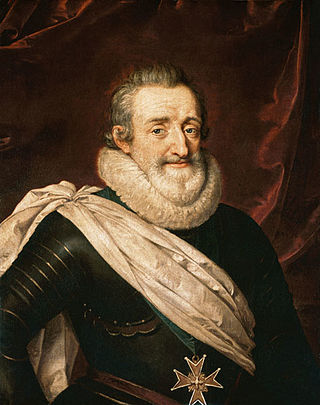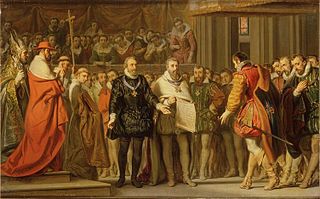Contents
| |||||
| Decades: | |||||
|---|---|---|---|---|---|
| See also: | Other events of 1598 History of France • Timeline • Years | ||||
Events from the year 1598 in France
| |||||
| Decades: | |||||
|---|---|---|---|---|---|
| See also: | Other events of 1598 History of France • Timeline • Years | ||||
Events from the year 1598 in France


1598 (MDXCVIII) was a common year starting on Thursday of the Gregorian calendar and a common year starting on Sunday of the Julian calendar, the 1598th year of the Common Era (CE) and Anno Domini (AD) designations, the 598th year of the 2nd millennium, the 98th year of the 16th century, and the 9th year of the 1590s decade. As of the start of 1598, the Gregorian calendar was 10 days ahead of the Julian calendar, which remained in localized use until 1923.

The Edict of Nantes was signed in April 1598 by King Henry IV and granted the minority Calvinist Protestants of France, also known as Huguenots, substantial rights in the nation, which was predominantly Catholic.

Henry IV, also known by the epithets Good King Henry or Henry the Great, was King of Navarre from 1572 and King of France from 1589 to 1610. He was the first monarch of France from the House of Bourbon, a cadet branch of the Capetian dynasty. He pragmatically balanced the interests of the Catholic and Protestant parties in France, as well as among the European states. He was assassinated in Paris in 1610 by a Catholic zealot, and was succeeded by his son Louis XIII.

Gabrielle d'Estrées, Duchess of Beaufort and Verneuil, Marchioness of Monceaux was a mistress, confidante and adviser of Henry IV of France. She is noted for her role in ending the religious civil wars that plagued France for more than 30 years.

The French Wars of Religion were a series of civil wars between French Catholics and Protestants from 1562 to 1598. Between two and four million people died from violence, famine or disease directly caused by the conflict, and it severely damaged the power of the French monarchy. One of its most notorious episodes was the St. Bartholomew's Day massacre in 1572. The fighting ended with a compromise in 1598, when Henry of Navarre, who had converted to Catholicism in 1593, was proclaimed King Henry IV of France and issued the Edict of Nantes, which granted substantial rights and freedoms to the Huguenots. However, Catholics continued to disapprove of Protestants and of Henry, and his assassination in 1610 triggered a fresh round of Huguenot rebellions in the 1620s.
Events from the year 1598 in art.

The Peace of Vervins or Treaty of Vervins was signed between the representatives of Henry IV of France and Philip II of Spain under the auspices of the papal legates of Clement VIII, on 2 May 1598 at the small town of Vervins in Picardy, northern France, close to the territory of the Habsburg Netherlands.

The Edict of Fontainebleau was an edict issued by French King Louis XIV and is also known as the Revocation of the Edict of Nantes. The Edict of Nantes (1598) had granted Huguenots the right to practice their religion without state persecution. Protestants had lost their independence in places of refuge under Cardinal Richelieu on account of their supposed insubordination, but they continued to live in comparative security and political contentment. From the outset, religious tolerance in France had been a royal, rather than popular, policy.
Camisards were Huguenots of the rugged and isolated Cévennes region and the neighbouring Vaunage in southern France. In the early 1700s, they raised a resistance against the persecutions which followed Louis XIV's Revocation of the Edict of Nantes, making Protestantism illegal. The Camisards operated throughout the mainly Protestant Cévennes and Vaunage regions including parts of the Camargue around Aigues Mortes. The revolt broke out in 1702, with the worst of the fighting continuing until 1704, then skirmishes until 1710 and a final peace by 1715. The Edict of Tolerance was not finally signed until 1787.

The Dragonnades was a policy implemented by Louis XIV in 1681 to force French Protestants known as Huguenots to convert to Roman Catholicism. It involved the billeting of dragoons of the French Royal Army in Huguenot households, with the soldiers being given implied permission to mistreat the inhabitants and damage or steal their possessions. Soldiers employed as part of this policy were derisively referred to as "missionary dragoons".
The secretary of state for protestant affairs, was the secretary of state in France during the "Ancien Régime" and Bourbon Restoration in charge of overseeing French Protestant affairs. From 1749 on, the position was combined with the position of secretary of state of the Maison du Roi.

Catherine of Bourbon was a Navarrese princess regent. She was the daughter of Queen Jeanne III of Navarre and King Antoine de Bourbon. She ruled the principality of Béarn in the name of her brother, King Henry III of Navarre, from 1576 until 1596.

The Edict of Versailles, also known as the Edict of Tolerance, was an official act that gave non-Catholics in France the access to civil rights formerly denied to them, which included the right to contract marriages without having to convert to the Catholic faith, but it denied them political rights and public worship. The edict was signed by King Louis XVI on 7 November 1787, and registered in the Parlement of Paris during the Ancien Régime on 29 January 1788. Its successful enactment was caused by persuasive arguments by prominent French philosophers and literary personalities of the day, including Anne-Robert-Jacques Turgot; Étienne François, duc de Choiseul, Americans such as Benjamin Franklin and especially the joint work of Guillaume-Chrétien de Lamoignon de Malesherbes, minister to Louis XVI, and Jean-Paul Rabaut Saint-Étienne, spokesman for the Protestant community in France.
Michel Villedo (1598–1667) was a French stonemason from Creuse, who became advisor and architect of royal buildings for Louis XIV of France.
Events of the year "1642 in France".
Events from the year 1600 in France
Events from the year 1685 in France
Events from the year 1525 in France
Events from the year 1606 in France.
Events from the year 1604 in France